Some posts on this site contain affiliate links. If you book or buy something through these links, I earn a small commission (at no extra cost to you). Take a look at my privacy policy for more information.
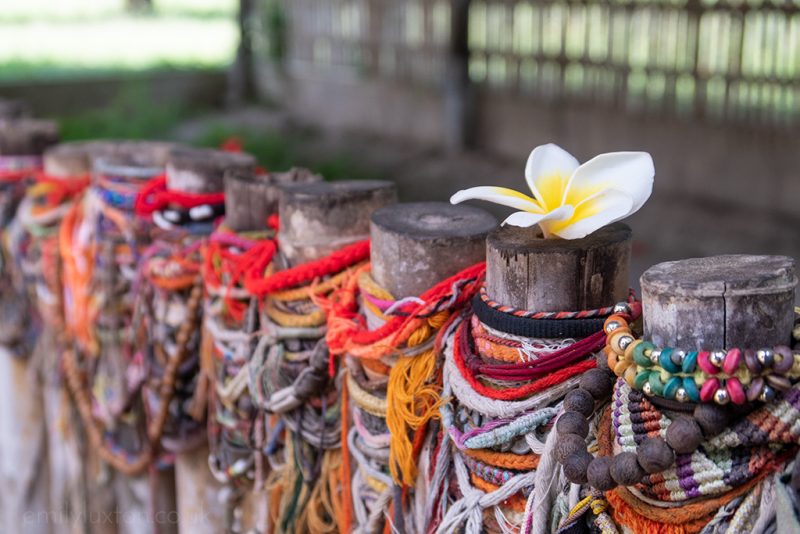
Should I visit the Killing Fields in Phnom Penh? This was the question I asked myself when I arrived in the city, with only one and a half days to explore.
Should I spend half of that time delving into the harrowing recent past of Cambodia – a country I only have a week in – when it would be so much more preferable to ignore it? When the alternative would be exploring the colourful culture I’d so fallen for, or eating some delicious food, or doing some other far more enjoyable activity.
But I went, because I know that some parts of our history should never be ignored. And, although I didn’t enjoy it, I’m glad I went. I came away feeling moved, and deeply saddened. I also came away more educated about an event which, in the West, it feels we have largely forgotten, but which still continues to scar this beautiful country today.
Killing Fields Phnom Penh Travel Guide
A quick note before I start this post properly. I wrote it shortly after visiting, but have put off publishing for several months. Why has it taken me so long? I think I was worried I wouldn’t be able to do justice to my feelings about the site, or why I think it’s so important to visit.
I was also very apprehensive about sharing the photos I’d taken. It felt odd taking photos of anything at all – because I didn’t want to treat these two places a tourist attraction. And I implore you, if you visit, not to treat them that way either. I took photographs because I wanted to report back, to share them with people back home who might never go to Cambodia. And I’m including them here because I want to show you what the Killing Fields and the Genocide Museum actually look like. I hope that it doesn’t seem disrespectful – because the intention is anything but.
1. Why You Should Visit the Killing Fields in Phnom Penh
When we travel, I think it’s important to try to understand as much of the local culture as possible. The events in Cambodia’s recent history have shaped the country into what it is today, so it’s important to acknowledge them and learn a little more about them.
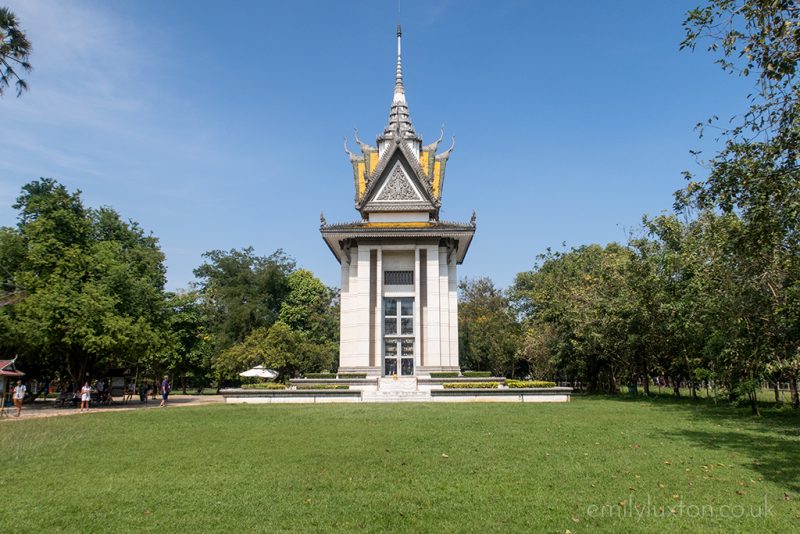
But the biggest reason why you should visit the Killing Fields and the Genocide Museum in Phnom Penh, is to keep the memory of these events alive and relevant. The sites were founded with the goal to educate people about what happened, in the hopes that it will never happen again. Cambodia wants to share these stories with the world, to pass the message down through the generations, so that it is never forgotten.
History Lesson or Horror Show?
As I mentioned above, it felt weird to take photos when I was there. To be wandering around these strangely tranquil sites in the warm sun, surrounded by lush greenery and colourful flowers. To be visiting such places as part of a tour, as if they were just another tourist attraction.
I worry that tourism to historic sites where great atrocities were committed runs the risk of turning them into horror shows, indulgences in the macabre. It feels odd to see places like the Killing Fields – or Auschwitz, or Chernobyl – listed as “tourist attractions” and rated on sites like TripAdvisor. Are we going because we want to learn, or because we want to be shocked and horrified? To ooh and aah and “oh isn’t it awful” at the monstrosities of the world, before going home to our comfortable, safe lives and putting it all away.
Go, but don’t treat it like a tourist attraction. Don’t take selfies with the skulls in the memorial, as I saw a pair of tourists do. Don’t pose in a colourful dress in front of the Killing Tree. Go to learn, to bear witness, to open your eyes to humankind’s capacity for evil. Go to make sure we don’t forget it.
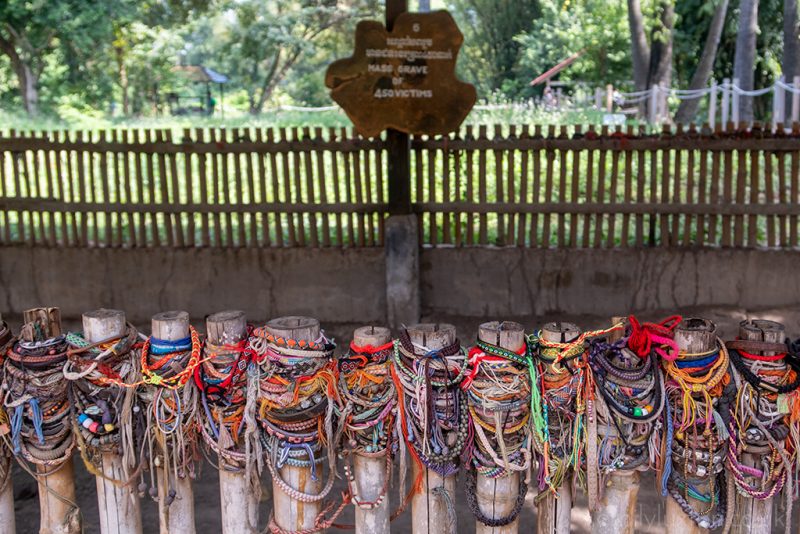
“Lest We Forget”
It wasn’t pleasant for me to visit the Killing Fields. One of the reasons I put off finishing this post for so long was that it was a harrowing experience. I didn’t want to look at the photos. I wanted to put the memory away and forget that such a horrible thing ever happened. It’s what I do frequently, with the news, with the things around the world I feel powerless to prevent.
Life is so much nicer when you forget the horrendous things that can, and do, go on every single day. But these things have happened, do happen, are happening. We shouldn’t forget – we should acknowledge and remember, and try to stop history repeating itself.
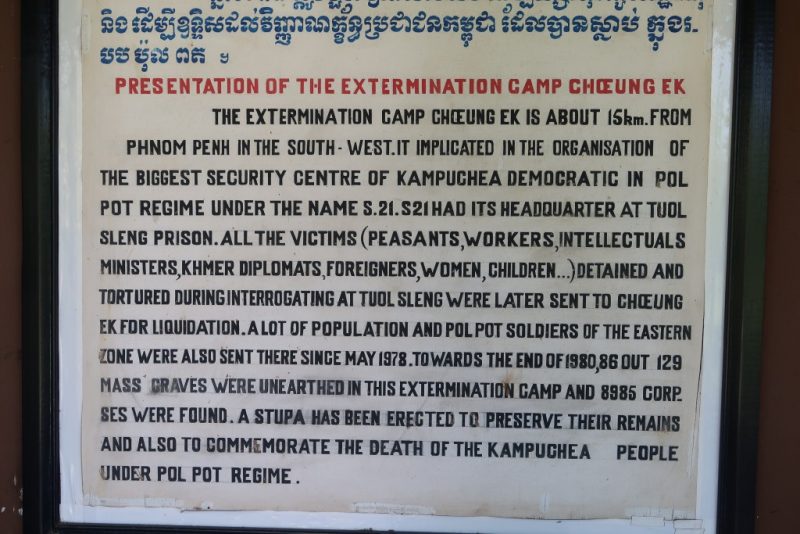
2. What are the Killing Fields – Some Context
From 1975 to 1979, Cambodia was ruled by the communist Khmer Rouge party, headed by the dictator Pol Pot. During that time, they slaughtered 25% of the country’s population in a shocking genocide. That’s one-quarter of the population: innocent men, women, children, even babies. If you want to understand it all, The BBC has a short but thorough history of the Khmer Rouge which you should check out.
The Killing Fields are more or less exactly what they sound like. At over 300 sites around the country, mass executions were carried out on a daily basis. The largest Killing Fields were at Choeung Ek, on the site of a former Chinese graveyard just outside of Phnom Penh. Today, the site serves as a museum, as well as a monument to the dead. Visitors can tour Choeung Ek to learn the unpleasant history, and to pay their respects to the dead.
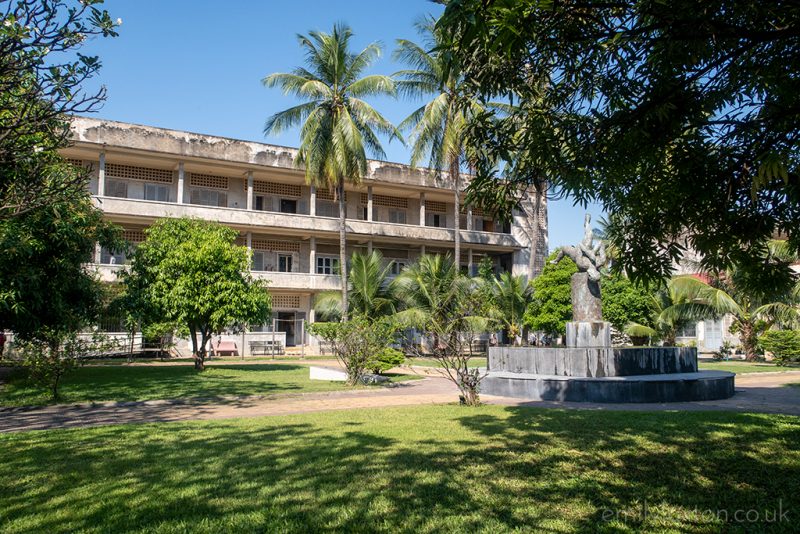
3. The Two Sites to Visit
Tuol Sleng Genocide Museum – The S-21 Prison
Originally a high school, during the Khmer Rouge regime Tuol Sleng was used as a prison for the containment, interrogation, and torture of prisoners. Today the prison has been kept largely as it was, and is run as the Tuol Sleng Genocide Museum sharing the true and harrowing stories of prison life.
Over the years, at least 12,000 people were tortured at Tuol Sleng – also known as S-21. Only 15 of them survived, and much of the museum’s information is drawn from their experiences.
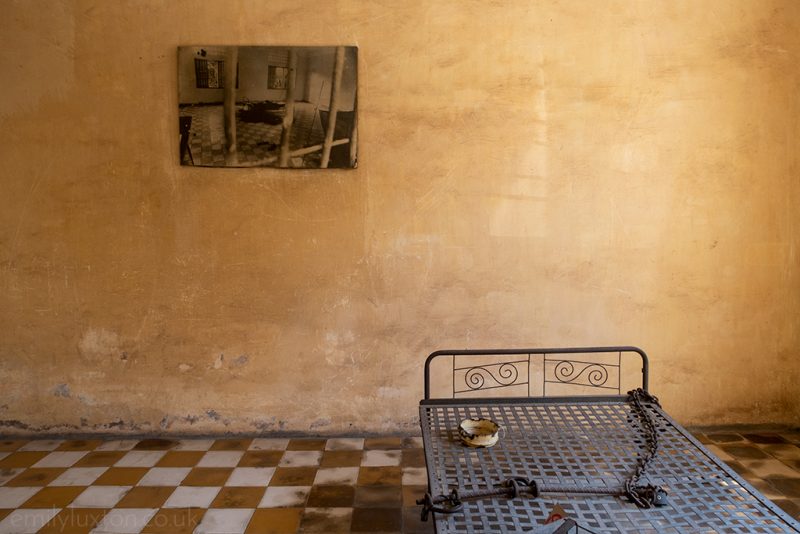
Killing Fields Phom Penh
Next are the Killing Fields themselves, which are just outside of Phnom Penh at Choeung Ek. This site was the biggest extermination camp in the country; in the space of just three years, about 17,000 men, women, children and infants were transported here.
Once a longan orchard, today Choeung Ek contains several mass graves. A short, self-guided tour connects various key spots around the site. I highly recommend buying the audio guide to listen as you walk round. There’s also a small museum on-site, and a memorial stupa where you can pay respects to the dead.
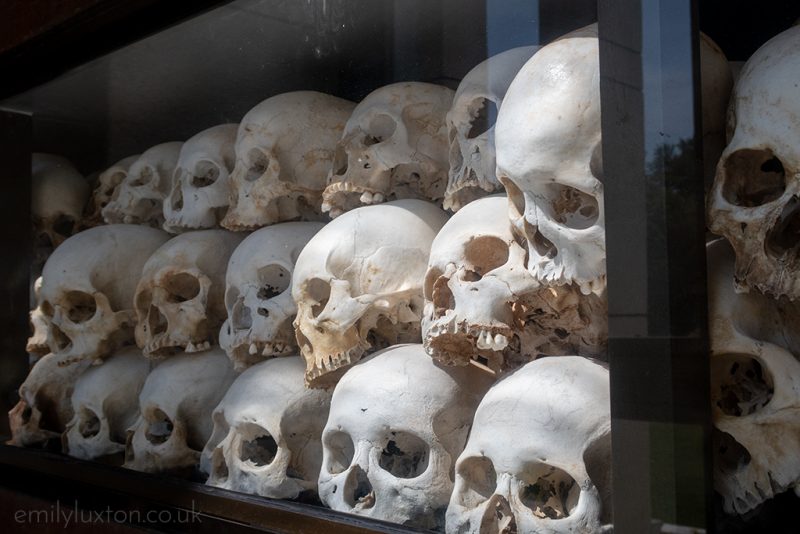
Which Order Should I Visit?
The most logical order is to visit the Genocide Museum first. Partly because the museum gives a little more context and background to the events. But also because this was the order in which prisoners would have travelled – first to the prison, for interrogation and torture. Then, to the Killing Fields for execution. It makes sense to follow the tragic journey in this chronological way.
4. What to Expect
Exploring the genocide museum and the Killing Fields in Phnom Penh is a far cry from a pleasant day out. For me, it was a crucial part of exploring the local history and understanding a bit more about Cambodia. I always try to advocate travelling a bit deeper, so this seemed like an important part of that.
I don’t want to tell you too much about it before you go. Partly because I want you to go and experience it for yourself. But also because it’s so hard to visualise the horrible facts of these histories until you’re actually standing there. It’s one thing to read about what happened on a screen and think, “well that sounds horrible” – but the reality of it becomes a lot more tangible when you can see it with your own eyes.
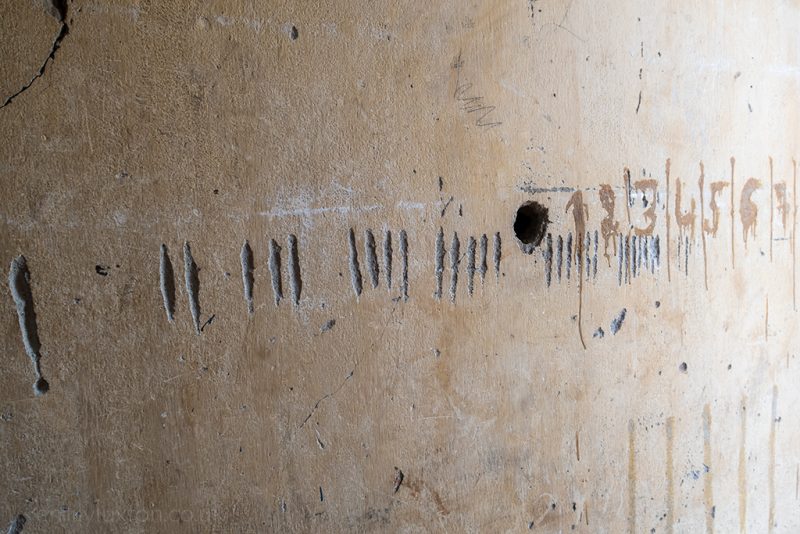
On the other hand, you’ll be confronted by some pretty brutal realities at both the museum and the Killing Fields in Phnom Penh. So it might be handy to know what to expect…
You will see the real cells that prisoners were kept in at the Genocide Museum. You’ll see photographs of dead bodies and hear/read real testimonies from survivors and prison guards. The audio guide, if you buy it, is narrated by real survivors.
At the Killing Fields, you will see mass graves filled with actual human bones and the scraps of clothing. There are over 8000 skulls, arranged by sex and age, behind clear glass panels in the Memorial Stupa. You will hear about the various torture and execution methods used by the guards. One of the most chilling sights is the notorious “killing tree” against which executioners beat infants to death. Today, it’s covered in colourful bracelets left in memorial by visitors.
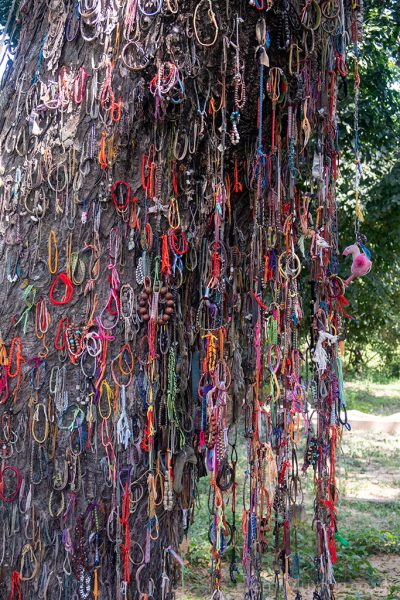
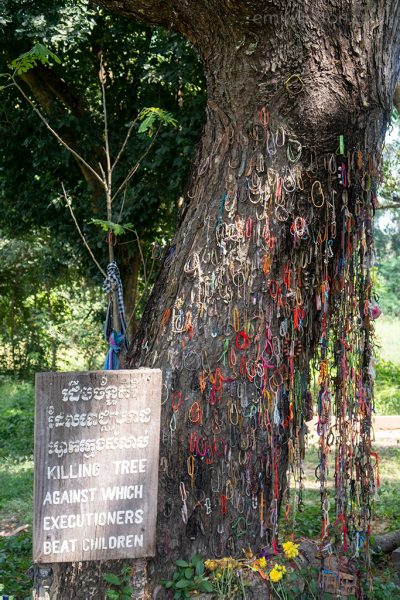
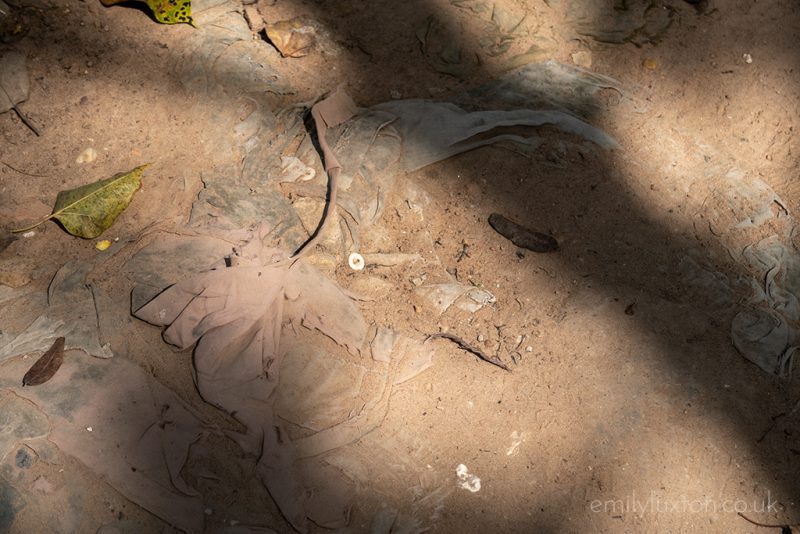
5. How to Visit the Killing Fields Phnom Penh
If you’re wondering how to get to the killing fields in Phnom Penh, these are the main options…
Killing Fields Bus Tour
There are a couple of local companies offering half-day bus tours for $15. I booked the Phnom Penh Hop on Hop Off Bus Half Day Tour through my hotel. The price includes hotel pick up and drop off, a guide on the bus, and a bottle of water. It doesn’t include any of your entry tickets or an actual tour guide – although they did play a documentary on the way which helped give a bit of background information on the Khmer Rouge etc.
It was easier for me to book the bus through the hotel and have it all arranged, but I felt like we didn’t have quite enough time at Tuol Sleng and I don’t think it was that much cheaper than doing it by rickshaw. If you want a bit more freedom, you might want to organise things yourself.
Cab / Rickshaw
Since the Tuol Sleng Genocide Museum is in the city centre, you may as well take a rickshaw there and explore at your leisure. I always use the Grab app (Asia’s answer to Uber) because then I know I’m paying a fair price. You may even be able to walk there depending on where you’re staying.
My hotel offered a private cab to the Killing Fields for $25, but I’m sure you can get this cheaper if you book direct with a driver and haggle. Or for about $10-15 you can take a tuk-tuk there and back.
Private or Small Group Tour
If you want more context and someone to facilitate everything, book an actual tour with a guide. There are plenty of small group tours to choose from, or you can book a private full-day tour of Phnomh Penh* which includes a trip to both the museum and the Killing Fields. This is a good option if you have limited time in the city and want to cover as much ground as possible – but it will be more expensive than exploring on your own.
Recommended Tour: Half-Day Tuol Sleng Museum and Cheung Ek Killing Fields* (small group tour from $26.30 on Viator.
Self Drive
You could rent a car or moped and drive yourself to the Killing Fields. The site is about 7.5km outside Phnom Penh and is well-signposted.
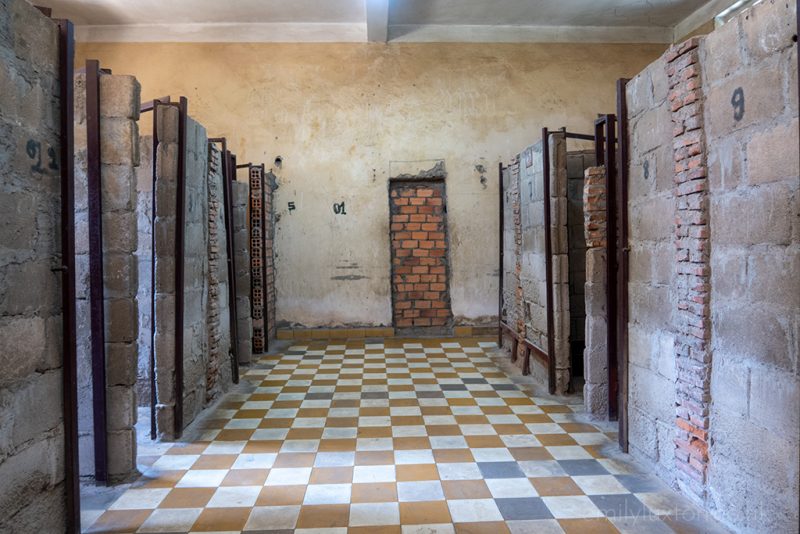
6. Important Things to Know
Entry Fees
Killing Fields: $3 plus $3 for an audio guide
Prison: $5 plus $3 for audio guide. Alternatively, you can pay $2-3 for a tour guide if one is available.
I highly recommend taking the audio guide for both the museum and the Killing Fields, as not much is written down or explained otherwise.
Is there a Dress Code for the Killing Fields?
There’a no official dress code for the Killing Fields or the Tuol Sleng Museum. But PLEASE use your common sense. Short skirts and shorts are not really appropriate, for example. I wore a long, loose skirt, and a t-shirt which covered my shoulders.
Please dress modestly. Show your respect for the dead, as well as for the still-living Cambodians for whom these sites are much more than just a sobering history lesson.
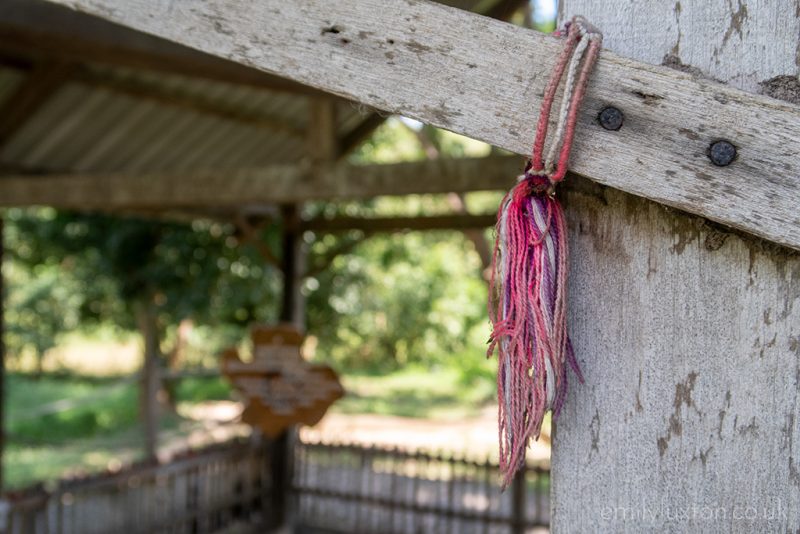
Behaviour
Again, remember that these are sites where people died and ought to be respected. This is Cambodia’s recent history and many people remember the time, and lost family members and loved ones during those years.
Be respectful and keep noise down. Don’t muck around or make jokes.
Also – think twice before posing for pictures or taking selfies. There’s a difference between taking a photo of something to share it with people back home, and using that something as a background for yourself. I saw a couple taking a selfie in the memorial, which contains cases of thousands of real human skulls. To me, that just seemed grossly inappropriate. Please exercise some common sense and consideration.
Do Get the Audio Guide
It is really worth paying for the audio guides at both The Killing Fields and the Genocide Museum, especially if you don’t have a tour guide with you. Both sites had very little English signage and not much was explained.
The audio guides were really good, and included recordings from actual survivors (and some Khmer Rouge guards). This is such recent history that the people who lived through it are able to share their stories, and this gave some really meaningful, moving context to the sites.
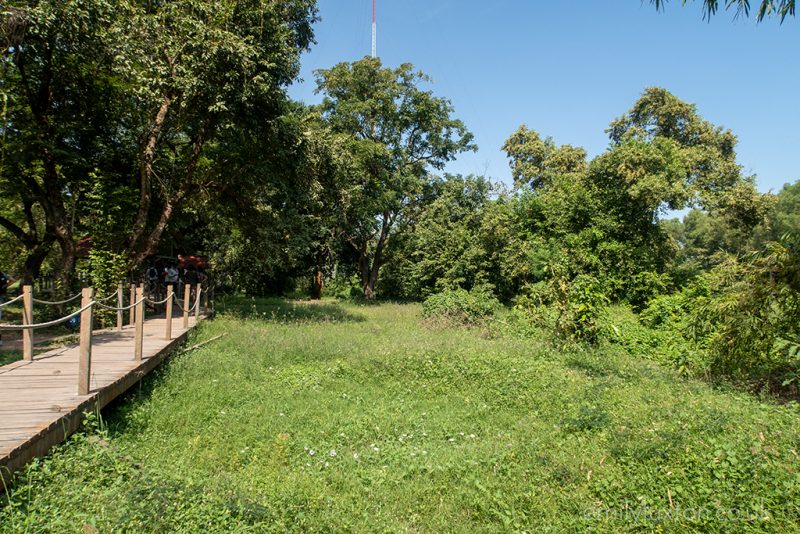
7. Learn More
If you want to learn more about the war and life under the Khmer Rouge regime, the below sources are some good places to start.
First They Killed my Father. This novel by Loung Ung is a true account of her family’s experiences in the Labour camps under the Khmer Rouge.
First they Killed my Father (movie). The 2017 movie directed by Angelina Jolie is a moving adaptation which remains faithful to the book as possible. It was produced for Netflix, and as far as I can tell you can only watch it there at the moment.
River of Time, Jon Swain. I read this very moving book by journalist Jon Swain a few years ago and highly recommend it. He lived and worked in Cambodia until the Khmer Rouge arrived in 1975. He also stayed in SE Asia while they were in power. This memoir is a powerful account of these events and their horrific aftermath.
The Killing Fields. A 1980s Hollywood movie that brought the genocide to the world’s attention. It’s a drama based on the true story of New York Times correspondent Sydney Schanberg and his Cambodian photographer and translator Dith Pran who remained in the country during the Khmer Rouge regime.
Survivor. This is the memoir of Chum Mey, one of the few survivors of Tuol Sleng Prison. It recounts what life was like for the detainees in S-21.
Read More
Check out my round-up of non-profit businesses in Cambodia to restore your faith in humanity. It was so nice to see so many places working towards a more hopeful future in Cambodia.

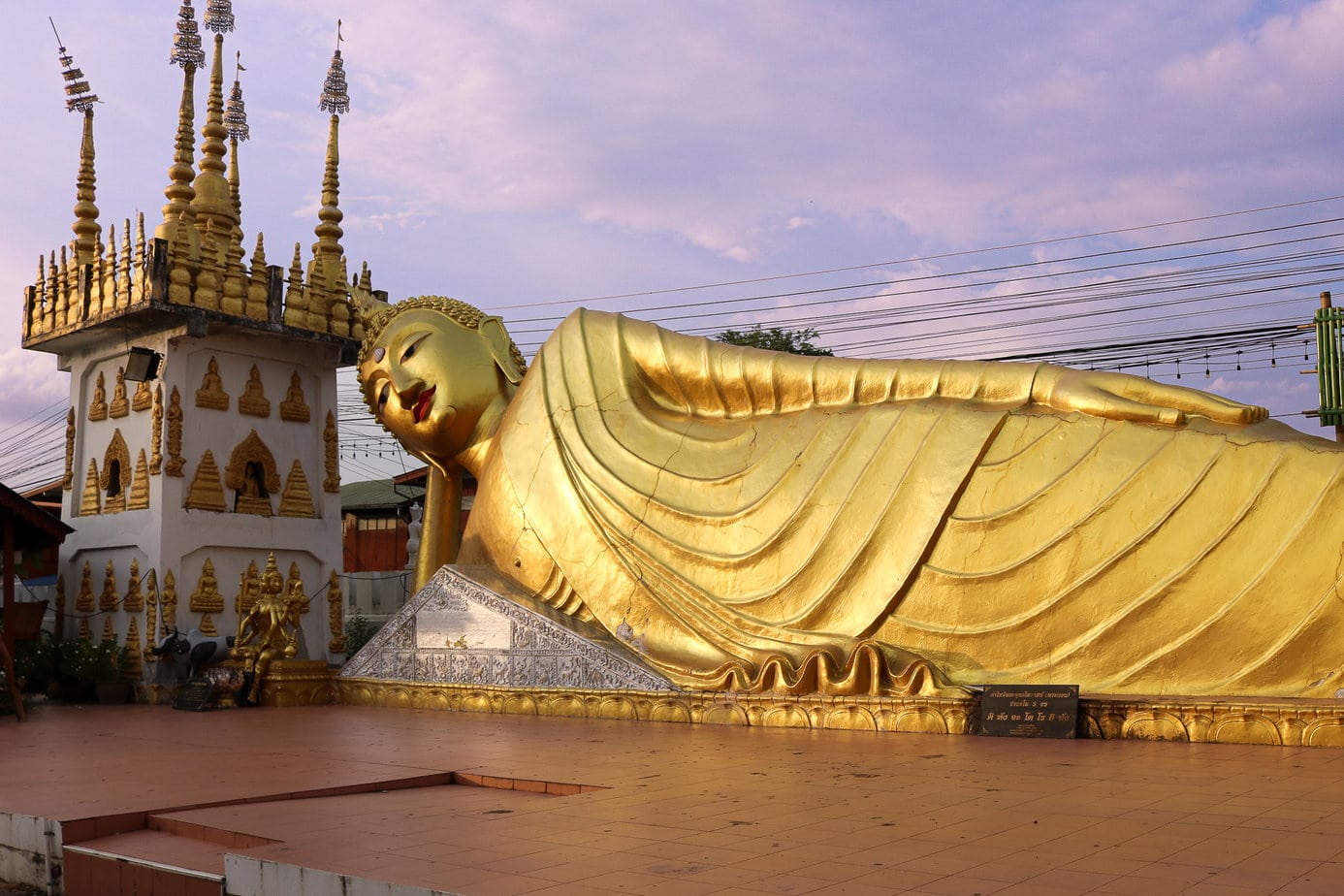
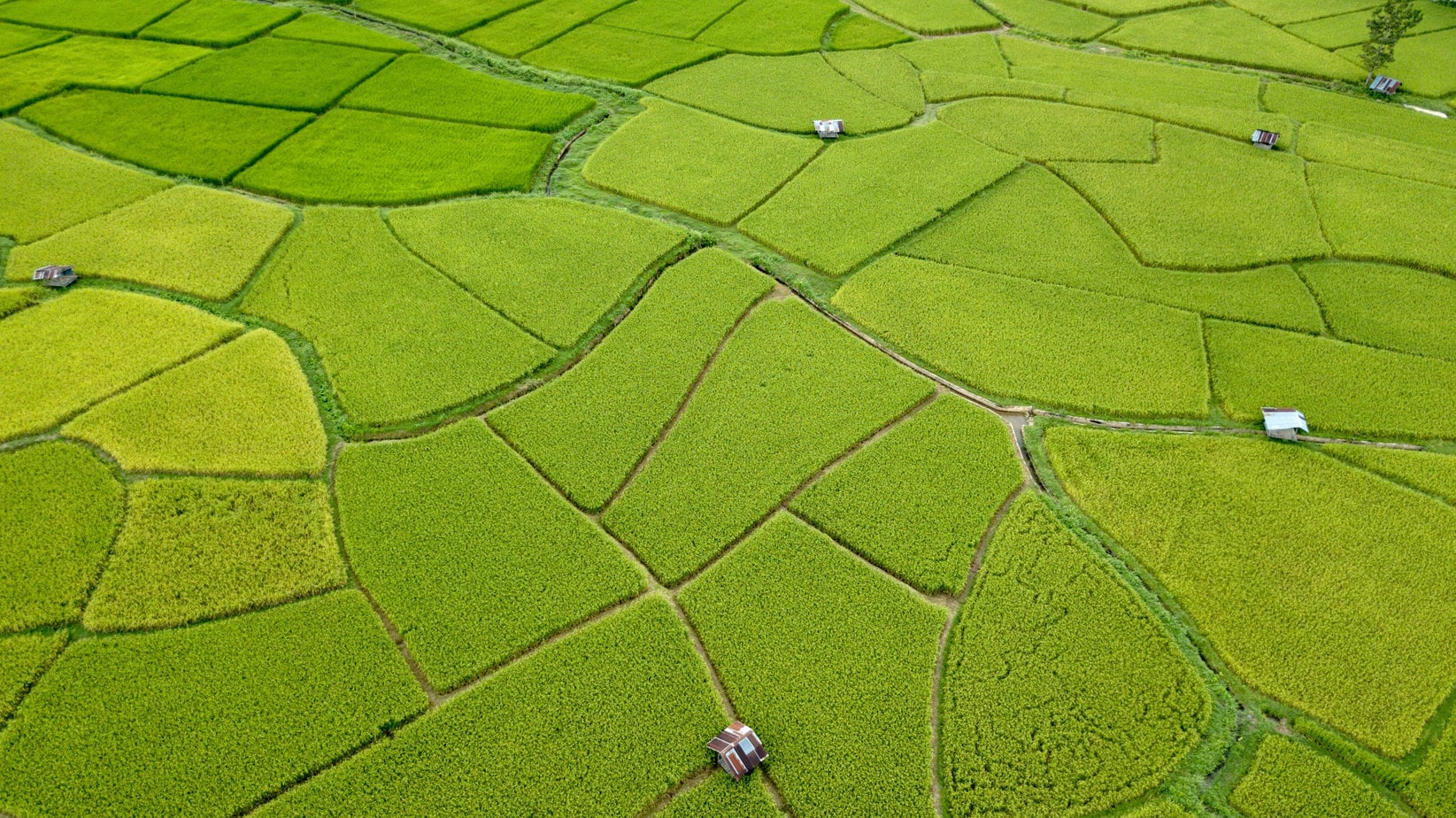
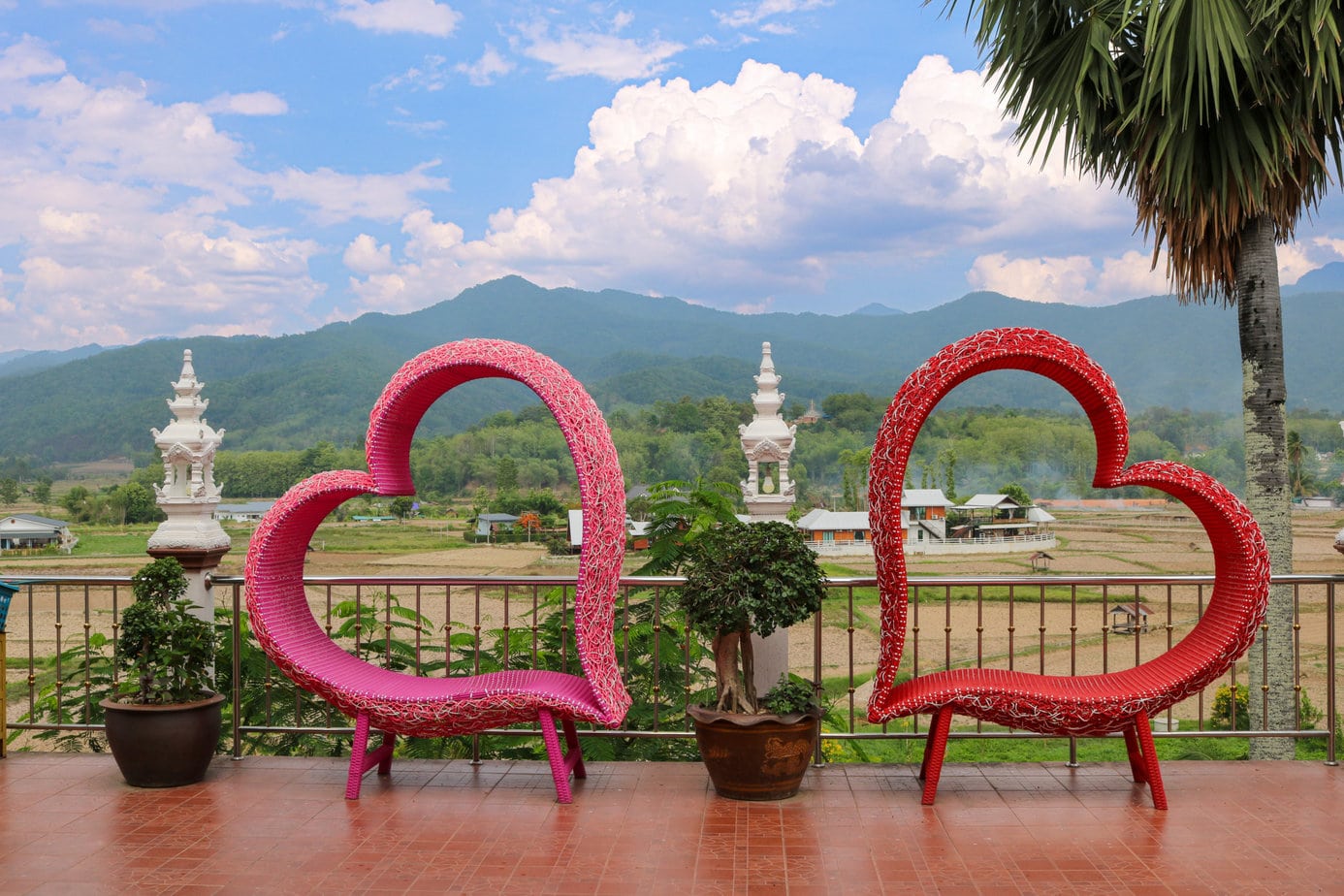
people taking selfies with skulls? Dear god what have we become? Such a solemn place – and I think very important that people visit. But without the selfies :(
I know right. Some people are just so… thoughtless.
My compliments for this article. It is 100% spot on. Having this place visited yesterday I felt embarrassed by noticing western people making selfies. Hopefully people will read your article before going.
Thank you so much for reading! I saw a few people taking selfies or posing for photos by the Killing Tree and it just seemed so inappropriate. I don’t get what goes on in some tourist’s minds!